-
Posts
919 -
Joined
-
Last visited
-
Days Won
255
Content Type
Profiles
Forums
Gallery
Events
Articles
Blogs
Downloads
Community Map
Posts posted by DianeB
-
-
I've discovered that the "Recent Status Updates" frame on the main page has a mind of its own. I deleted Mike's (Popeye's) birthday message for me (I love ya, Mike, but who wants to see that every day?), only to find it was replaced by one of Steve's old LL blurbs. Deleting that only displayed the next, even older blurb from Steve. I give up. 🤨
-
 1
1
-
-
@josev I'm not aware of any errata that have been collected -- other than the Lesson Book's Canon in D that was corrected in the Bonus Book: similar glitch. Steve used Finale to create the music notation, and I've heard him say on multiple occasions that the software sometimes does not generate the correct tab when he places a note on the staff, and he would have to correct it manually. I see what you're referring to, and he probably just didn't notice it. In this instance it should be obvious how to properly fret the strings. Good eye.
-
@mPasGamer I had to check to be sure, but, no -- the Song Hits set is comprised of 10 DVDs. Each has an introduction, an instruction, and a performance section by Steve. You can, of course, play along with Steve. By definition, on a backing track someone is playing something. But there are no "jam-along" CDs like those found in the L&M Guitar Course.
-
 1
1
-
 1
1
-
-
@dan0725 Dan, yes, those are slurs, as the curved lines connects notes of different pitch. It means the notes are to be sounded legato -- in this instance, I believe as sung, rather than played, from my reading of the lyric and the tab.
-
 2
2
-
-
Beautiful guitar! I love the sound of a 12-string. Enjoy!
-
@BenBob Well, hello, stranger! Long time, no see! Good to have you back.
-
 1
1
-
-
Repeats can be indicated in various ways; one being the measure repeat symbol (
 ). Some others are illustrated here.
). Some others are illustrated here.
-
@ChrisJ032 Chris, here's the exercise by Phil Keaggy that Dave describes above.
-
 1
1
-
-
@Stefan Hi, Stefan, at this stage, having learned the key signatures, you should be also able to identify all the relative major/relative minor pairs (B major -> G# minor, Eb minor -> Gb major, and so on). I made my own flash cards for this. It's also time (I think) to start learning, in some way, the circle of fifths (here's my recommendation). Steve does not take up this topic directly; he covers an absolute minimum of music theory in the course itself, probably to make it seem less intimidating.
Session 9 introduces intervals. This subject, too, is diluted: all the exercises deal with intervals above a pitch; none ask about intervals below a given pitch; and the student is not required to locate any of them on the staff. I see what Steve is doing: he's preparing the student to spell chords in the shortest (ahem) interval possible. But Session 13 is a long time to wait to understand what a triad is.
Around this point in the course, I suspect, each of us decides just what our relationship with music theory should be. As for me, I've completed all the theory topics in the course and more. It's worth it. Carry on!
-
 2
2
-
 1
1
-
-
December 10th, 2019
-
 3
3
-
 1
1
-
-
@Triple-o This article should answer your questions. The fees that licensing companies and publishers charge will vary, depending on the intended use.
-
22 hours ago, Quilter1958 said:
You deserve that guitar, Diane!
Sherry, I appreciate you thinking of me, but, um, I think you meant to say, "Maria"!
-
@Oldjock Apparently so. I don't have the app, but I did find this in the online instruction manual. You might want to explore the descriptions of other settings. For optimum readability, it would probably work best on the larger iPad Pro.
Scale
Instead of making all monospaced fonts in tablature a common size, OnSong provides a scale for the font. This allows the size of the tablature to be adjusted along with the chords and lyrics sizes. Options include values between 30% and 130% in 10% increments. Default is 100% of the size of the chord font size.
-
 2
2
-
-
@NeilES335 Congratulations, Neil! Quite an accomplishment! Well done! 🙋♀️
-
 1
1
-
-
@zeve Your question comes up regularly as students start out in the course. Steve has addressed it several times here in the forum and on live lessons, and I’ll paraphrase: you can learn to play guitar without learning to read music notation. Tablature has its place, but it is a guitar-specific, limited vocabulary, language.
Tablature shows where, and sometimes when, to place the fingers, but it says nothing about why. With tablature, it is all but impossible to see how a bass line or melody moves, what kind of modulation may be taking place, or what intervals or chords are in use. These are in plain view when music is written on the staff, and from there you can often choose your fingerings.
Music notation is perhaps the most universally recognized printed language we have. It’s understood by singers, pianists, drummers, trumpet players, and violinists around the world. How tragic it would be to go through life and see nothing on a page of printed music but lines and dots.
-
 2
2
-
-
On 11/18/2019 at 9:12 AM, Triple-o said:
I’ve come to the conclusion that the C.1 is a reference to the chorus section.
Ohhh. That was really ambiguous without context.
-
Just a reminder: Steve and the Belmont Guitar Ensemble are on tonight, Tuesday, November 19!
-
 1
1
-
-
@zeve Hello, zeve, and welcome to the course and the forum! It's great to see someone new join in.
What you are experiencing is entirely normal. Everyone goes through this. At this early stage, you are asking your fingers to move in strange, unfamiliar, and unnatural ways. They don't know how (yet), so they tend to revert to their more familiar and comfortable positions. Regard them as toddlers learning to walk. Approximations, misses, buzzes are all fine for now. Stretch, rest, and stretch some more. Stop if it hurts. Come back to it later. Your fingertips will toughen up. Do not place a time frame or deadline on any particular skill. Go slow, get it as close as you can, repeat, repeat, repeat, and it will come.
Do not be concerned if you can not land a full C or G7 chord at this stage; Steve is merely making you aware of what a chord is like, and a chord only requires three notes.
If at all possible, find a teacher who can encourage you and help you develop good technique and practice habits. You don't want to practice mistakes. If that's not possible, absorb as much of the collected wisdom of good teachers as you can. And everyone here on the discussion board is here to help you along the way!
-
 2
2
-
-
@Triple-o We mustn't leave you feeling lonely and dreary! A full Fmaj9 is, of course, F-A-C-E-G (1-3-5-7-9), requiring a minimum of root (F), major third (A), major seventh (E), and major ninth (G) intervals. The fifth is often absent. If the seventh is absent, then technically we have an Fadd9 (or Fadd2). In the G-F-A voicing/inversion you cite, I suspect that's just a consequence of the way the voicings are moving in the melody at that beat.
-
 1
1
-
-
Annoying, yes, but there is a simple explanation for why the printed music to many published songs do not include guitar or other instrumental solos. The published music is (almost always) copyrighted, and that requires that whatever is in fixed form be the original work of the author(s), in this situation, the songwriter(s). This normally means the melody, lyrics, and chords. At recording time, any number of embellishments might be added by others: intros, riffs, solos, background vocals, and so on. These may or may not appear in the published music credited to the songwriters, as the recording is typically copyrighted by the production company. Moreover, the owner of the publishing and performance rights is likely a third entity, a licensing company.
-
-
Well, gang, I'm finally home. Thank you for reading and for all your kind words. Correction: the song Steve and Gregg (on the far left in the group photo) played that roused me from my nap so sweetly was Orleans' "Dance with Me". Don Ross is third from the right. The only persons not pictured, I think, are Collin, who was off to do a podcast that afternoon, and, of course, our photographer Chuck. The winner of the big prize, a Fishman Bluetooth-equipped Loudbox Mini, was my roomie Marion, a mere 9,000 miles from her home in Brisbane, Australia. Now, that's dedication.
-
 3
3
-
-
Eat, tune, play. Just as we get settled into our rooms, adapt to our new routine, and get acquainted, it's time to wrap up. We started with an early 7:30 breakfast, finger exercises, and a bit more ear training. Our final lesson was a kind of panel discussion with Van Larkins, Collin, and Steve in the living room. They offered their thoughts on real world guitar learning. The practice world: mechanics, metronomes, scheduling, goals, motivation, and dealing with frustration. And the performance world: focus, automaticity, dealing with the unexpected and stage fright.
I sat in a literal corner, still wearing my metaphorical dunce cap from Thursday night. Don't you dare wear that home, my teachers implored. As I listened, I imagined myself reaching up, snatching the thing from my head and heaving it away into the lobby.
Finally it was time to leave. The sweet music that had filled the lodge was now replaced by the bass of thumping guitar cases and the treble of excited goodbyes. Hugs for all, from all. This is my guitar family. As Steve said this week, we leave no one behind. We're on the same mission, no matter what our skill -- to bring some beauty, some love, some magic into the world.
I found Patrick. We loaded our gear into my car, and set off for the airport for his return flight. In a few days, my new friend will be in the cockpit of an Air Canada jetliner somewhere over the Pacific on his usual run. Later, he will check into his hotel in Shanghai, retrieve the guitar he keeps there, and add another layer of polish to "Autumn Leaves".
Meanwhile, on the other side of the world, I will pick up my guitar, with her new spandex-ey nylon strings and prop her up on my left leg. I will recall Steve eagerly coaxing, "Diane, come on, get up here." I'll be back. I haven't been left behind.
-
 4
4
-
-
After warm ups today, almost everyone crowded the living room for Collin's lesson. I took a chance and checked into Steve's cozier session on jazz voicings. I knew I had no chance of playing those progressions. But I held my own with the music theory, so I extracted a morsel of satisfaction.
We enjoyed an afternoon workshop on ear training -- identifying the I, IV, V, and vi, that is -- then Don Ross arrived to get us psyched for the evening concert. After a bit of baritone funk, it was time for recess.
I was roused from my nap by the familiar riff of Orleans' "Still the One" filtering up from the dining room. The source was Gregg and Steve, rehearsing. I stared, mesmerized.
After dinner, we had time for a few more student performances. But to my ear, these were too polished and proficient for the word "student". Gregg and Steve performed their duet of "Dance with Me", then Steve officially announced the dates for next year's retreat (Halloween week again). Next we made room for virtuoso Don Ross, with his fan fretted guitars and harp guitar. Don fought off a cold and sleep deprivation (airline issues) to put on a killer show.
We took a break for ice cream floats. I plopped into a couch with my nylon and discreetly shadowed Vic's progression for a few bars. Dave appeared with a new Maton fresh from Artisan's, and Collin helped him break it in. Vic and Patrick took turns, then Carol gave us an impressive "Classical Gas". The music went on until we were all exhausted.
We pick up an hour tonight but have to start a half hour earlier in the morning. Forgive my brevity, but I'm fuzzier than year old Elixir Polywebs. The finish line approaches.
-
 5
5
-
 1
1
-

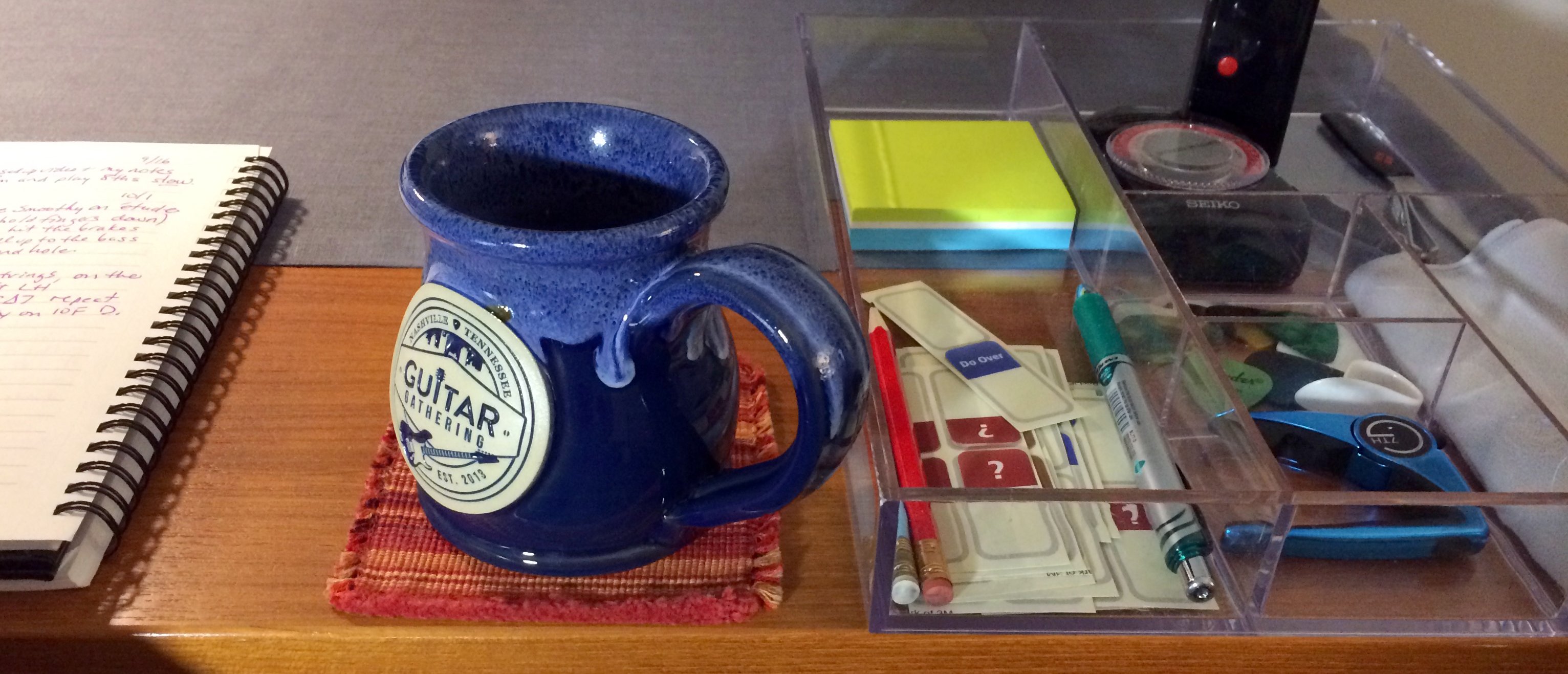
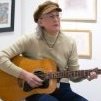

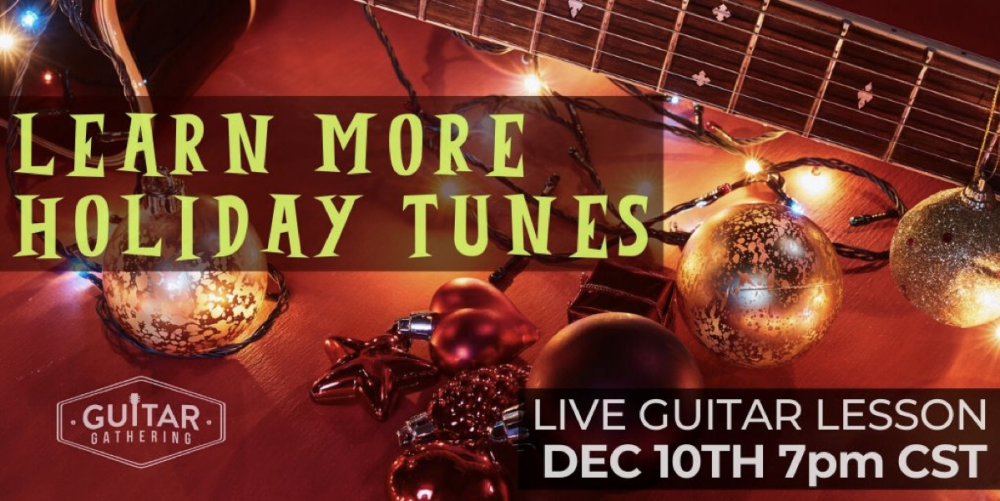
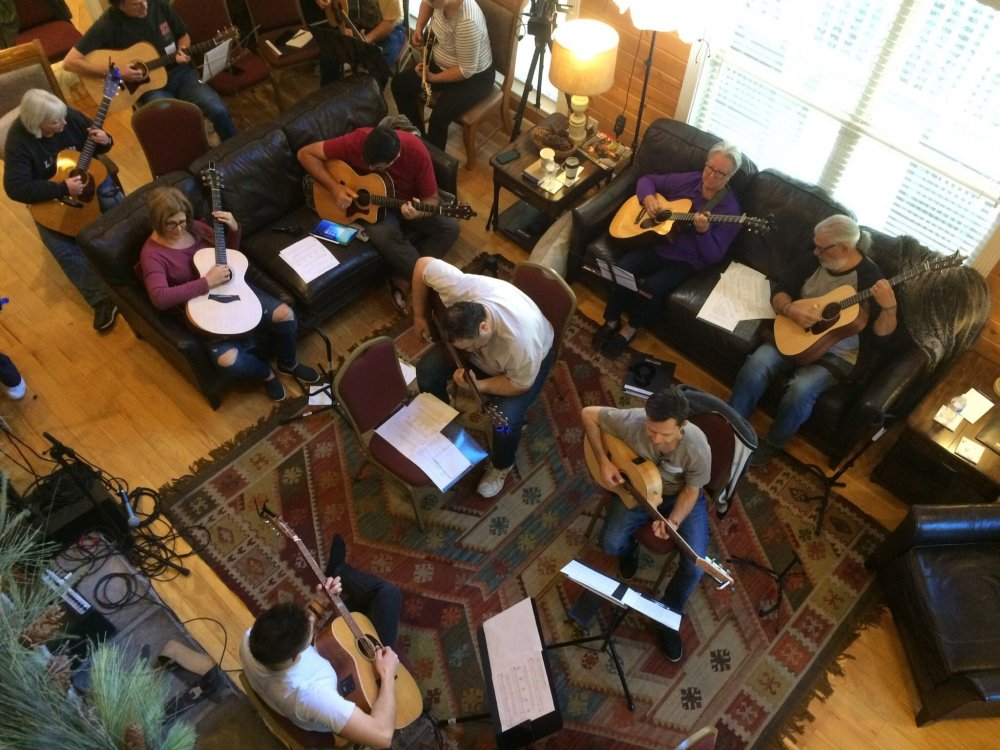
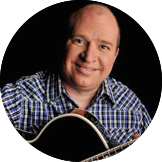
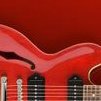
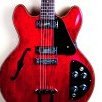
L&mg song's
in Learn & Master Course Questions
Posted
@T. W. Hello, Terry! Welcome to the forum and the course! In the beginning, memorizing the music is not the point. It's about developing basic hand skills and familiarity in playing guitar from printed music. Steve expects a student to be referring to the printed music as they work their way through playing along with the jam tracks. Being able to play a song from memory will be a happy side effect of sufficient practice, but is never a requirement for progressing through the sessions.